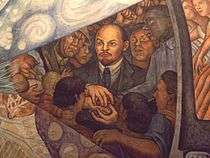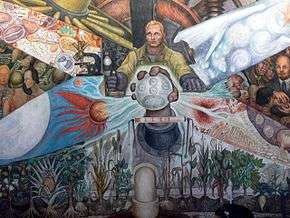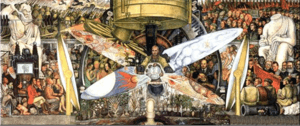Man at the Crossroads
|
The recreated version of the painting, known as Man, Controller of the Universe | |
| Artist | Diego Rivera |
|---|---|
| Year | 1934 |
Man at the Crossroads (1934) was a fresco by Diego Rivera in New York City's Rockefeller Center. The painting was controversial because it included an image of Lenin and a Soviet Russian May Day parade. Despite protests from artists, Nelson Rockefeller ordered its destruction before it was completed.
Only black-and-white photographs exist of the original incomplete mural, taken when Rivera was forced to stop work on it. Using the photographs, Rivera repainted the composition in Mexico under the variant title Man, Controller of the Universe.
The creation and destruction of the mural is dramatized in the films Cradle Will Rock (1999) and Frida (2002).
Commission
 | |
|
|
The Rockefellers wanted to have a mural put on the ground-floor wall of Rockefeller Center. Nelson Rockefeller wanted Henri Matisse or Pablo Picasso to do it because he favored their modern style, but neither was available. Diego Rivera was one of Nelson Rockefeller's mother's favorite artists and therefore was commissioned to create the huge mural. He was given a theme: "Man at the Crossroads Looking with Hope and High Vision to the Choosing of a New and Better Future."[2] Rockefeller wanted the painting to make people pause and think.[3] Rivera was to be paid $21,000 for the work.[4] He was officially commissioned by Todd-Robertson-Todd Engineering, the development agents for the building. The full commission envisaged three murals. Man at the Crossroads would be in the center. It would be flanked by The Frontier of Ethical Evolution and The Frontier of Material Development. The central composition was intended to contrast Capitalism and Socialism.[5]
Work

Rivera's composition depicted many aspects of contemporary social and scientific culture. In the center, a workman was depicted controlling machinery. Before him, a giant fist emerged holding an orb depicting the recombination of atoms and dividing cells in acts of chemical and biological generation.[4] From the central figure four propeller-like shapes stretched to the corner of the composition, depicting arcs of light created by giant lenses anchoring the left and right edges of the space. Rivera described these as "elongated ellipses". Within these, cosmological and biological forces such as exploding suns and cell-forms were depicted. These represented the discoveries made possible by the telescope and the microscope.[4]
Between and beyond the arcs were scenes of modern social life. Wealthy society women are seen playing cards and smoking at the left. Opposite, on the right, Lenin is seen holding hands with a multi-racial group of workers. Soldiers and war machinery occupied the top left above the society women, and a Russian May Day rally with red flags was seen at the right, above Lenin. For Rivera, this represented contrasting social visions: the "debauched rich" watched by the unemployed while war rages; and a socialist utopia ushered in by Lenin.[4] Beyond the giant lenses to left and right were depicted figures contemplating the central scene, behind which were gigantic classical statues. The one on the left depicted an angry Jupiter, whose raised hand holding a thunderbolt has been struck off by a lightning strike. The one on the right was a headless seated Caesar. For Rivera these represented the replacement of superstition by scientific mastery of nature, and the overthrow of authoritarian rule by liberated workers.[5]
The bottom part of the painting was to depict the controlled growth of natural resources, in the form of a variety of plants emerging from their roots, visible in a cut-away view under the soil. However, this section was never completed. It exists only in the later recreation of the composition in Mexico.
Destruction
On April 24, 1933 the New York World-Telegram newspaper published an article attacking the mural as anti-capitalist propaganda.[6] A few days later Rivera added the portrait of Lenin to the work. This precipitated a major controversy by May. The bad publicity greatly upset Rockefeller.[3] Rivera was asked to remove the picture of Lenin, but refused, instead offering to add Abraham Lincoln to the work as way of a compromise.[6] Rockefeller then left the decision about the future of the mural to Todd-Robertson-Todd. Rivera was fully paid the promised amount for his work, but the mural was covered in drapery and left incomplete.[6] Despite protests from art lovers and attempts to get it to moved to the Museum of Modern Art, it remained covered until the early weeks of 1934, when it was destroyed by workmen.[6]
The destruction caused widespread controversy. Ralph Stackpole and Bernard Zakheim (who headed a group of artists commissioned by the WPA to paint murals at the Coit Tower in San Francisco) protested, and also included references to the incident in the form of headlines in newspapers held by figures in their paintings.[7]
The Rockefeller Center commissioned a mural by Josep Maria Sert entitled American Progress to replace Rivera's work. It used Abraham Lincoln as its focal point.
Recreation

Concerned that Rockefeller would destroy the work, Rivera had asked an assistant, Lucienne Bloch, to take photographs of the mural before it was destroyed. Using them as a reference, Rivera repainted the mural, though at a smaller scale, at the Palacio de Bellas Artes in Mexico City where it was renamed Man, Controller of the Universe.[3] The composition was almost identical, the main difference being that the central figure was moved slightly to be aligned with the supporting mast of the cylindrical telescope above him.[8]
The new version included a portrait of Leon Trotsky alongside Karl Marx and Friedrich Engels at the right.
Others, including Charles Darwin, appear at the left, including Nelson Rockefeller's father, John D. Rockefeller, Jr., a lifelong teetotaler, seen drinking in a nightclub with a woman; above their heads is a dish of syphilis bacteria.[8]
Cultural significance
The Rockefeller-Rivera dispute has become an emblem of the relationship of politics, aesthetics, creative freedom and economic power. The American poet Archibald MacLeish's 1933 collection Frescoes for Mr. Rockefeller's City was inspired by the incident. It included six "irony-laden" poems about the mural in which both Rockefeller and Rivera were criticised.[9] The New Yorker magazine published E. B. White's poem "I paint what I see: A ballad of artistic integrity" on May 20, 1933, an imaginary debate between Rockefeller and Rivera.[10]
It has been discussed or dramatized in a number of films dealing with the politics of art. The events are dramatized in the American films Cradle Will Rock and Frida, both set in the 1930s. In Cradle Will Rock, the painting depicted is identical to the Mexican version. When it is smashed, only the fragment of plaster containing the depiction of syphilis remains.
It is also discussed in the Tamil film Anbe Sivam, in which an Indian Communist argues with a supporter of the capitalist system.
See also
- Detroit Industry Murals (1932–1933)
- Diego Rivera
References
- ↑ "Diego Rivera, Man Controller of the Universe". Smarthistory. Retrieved May 9, 2016.
- ↑ "My Art, My Life: An Autobiography". New York: Dover, 1991. p. 125. ISBN 0-486-26938-8
- 1 2 3 "Rockefeller Controversy". Diego Rivera Prints. Retrieved October 2, 2007.
- 1 2 3 4 Greenberg, Brian, et al, Social History of the United States, ABC-CLIO, 2008, p325.
- 1 2 Gamboni, Dario (1997). The Destruction of Art: Iconoclasm and Vandalism Since the French Revolution. Reaktion Books. p. 142. ISBN 9780948462948.
- 1 2 3 4 "Diego Rivera's Man at the crossroads". PBS. Retrieved August 7, 2013.
- ↑ Lee, Anthony W. (1999). Painting on the Left: Diego Rivera, Radical Politics, and San Francisco's Public Murals. University of California Press. ISBN 0-520-21977-5.
- 1 2 Manuel Aguilar-Moreno, Erika Cabrera, Diego Rivera: A Biography, ABC-CLIO, 2011, P.68.
- ↑ "Archibald MacLeish Criticism". Enotes.com. Retrieved December 8, 2011.
- ↑ "''I paint what I see''". Art-talks.org. May 20, 1933. Retrieved December 8, 2011.
